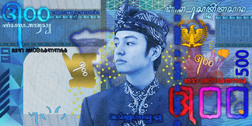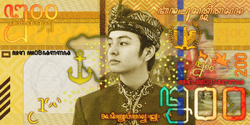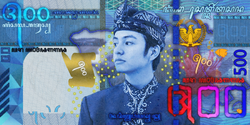Kertic Mas
| ꦩꦱ꧀ Mas (Kertic) | |
|---|---|
 11th Mas series released for Adityawrman III (2021) | |
| Unit | |
| Plural | p |
| Symbol | ℳ |
| Denominations | |
| Subunit | |
| 1/100 | Peser |
| Banknotes | |
| Freq. used | ℳ 10, 20, 50, 100, 200, 500 |
| Rarely used | ℳ 5 |
| Coins | |
| Freq. used | 5, 10, 25, 50p ℳ 1, 2, 5 |
| Rarely used | 1, 2p |
| Demographics | |
| Date of introduction | 18 June 1902 |
| User(s) | Kertosono |
| Issuance | |
| Central bank | Central Bank of Kertosono |
| Valuation | |
| Inflation | 1% |
The Kertic Mas (Kertic: ꦩꦱ꧀ꦏꦼꦂꦠꦱꦤ, "Mas Kêrtåsånå") is the national currency of Kertosono. It is controlled and issued by the Central Bank of Kertosono with an ISO code of KRM. Originally a currency union between Kertic states, it was made a singular currency with a sungular monetary authority for all of Kertosono upon the creation and unification of Kertosono in 1901. It was decimalized in 1987 when 320 old pesers formed into 100 new pesers. The Kertic Mas is the sole official legal tender within Kertosono, as the use of any other currency as a medium of exchange within the country has been made illegal since 2004.
The Mas was originally known as the standard currency as a currency union between 12 Kertic states in 1878, one of which included the Kingdom of Ngawi. The curency union mandated the issuance of the same weights in silver and gold, as well as a unified monetary policy, sparking the beginnings of the modern Kertic Mas and its institutions. Upon unification, the Mas along with the standardized weights in silver and gold were carried on with slight modifications to accomodate most of the eastern states which were new to the currency union. The Common Currency Board of Eastern Kertosono became was the predecessor to the Central Bank of Kertosono, becoming the official institution for the country in 1902, one year after the adoption of the Mas. In 1967, the silver and gold standard was abandoned, and the currency wholly became a fiat currency.
History
In 1878, 12 Kertic states led by the Kingdom of Ngawi signed and ratified what is now known as the "Eastern Kertic Currency Union", which would standardize all circulating coins and banknotes in terms of composition as well as face value in order to make individual states' currencies be legal tender and be accepted accross the currency union. A set system comprising of conversion tables as well as the material composition for the coins and the banknotes were agreed upon, thus creating the first known bridge between the different currencies used in various Kertic states, even though some smaller political entities have done so in a much reduced scale and scope with one another. In 1900, when talks of unification among the diverse Kertic states were in full swing, the issue of currency was a crucial matter.
The EKCU would serve as the base for the 1900 treaty of currencies, in which the major powers Kertonyono and Sragen agreed to enter into a currency union with the EKCU before gradually transitioning into a single currency by 1902. As a concession, the central bank of Kertosono would be located in Kertonyono, and the mint would be located in Sragen. The overall consequences of such treaty being ratified into law quickly was that all the coins of non-EKCU currencies were accepted not at face value, but their worth in either gold or silver, causing the buying power of Kertonyono and Sragen citizens to decline somewhat. In an effort to curtail the effects of devaluation as well as to keep reunification spirits high, in the following month the transitional comitte of unification declared that all coins would be worth face value until a singular currency could be agreed upon.
Shortly after the ratification of the union treaties in 1901, the currency board of Kertosono was formed, whose main goal was to create and promulgate a new currency for the entire nation, and to ease the transition from the status quo unto the new currency. Representatives from all over the empire were invited into the 'currency conventions' in mid 1901, and agreed on a new currency which would be known as the "Kertic Mas", and would be heavily based on the preceding EKCU in terms of material makeup and conversion. It was agreed that one Kertic Mas would equal 16 Perak, with each Perak equaling 20 Pesers. The silver and gold makeup of the currencies would later be regulated by law, and would undergo several debasements until 1967 when the gold and silver standard was dropped, which meant that all coins would be made of more representative materials such as nickel or alumunium. The currency was introduced in 1902, and the currency board of Kertosono became the Central Bank of Kertosono. In a gentlemen's agreement between the various kertic states, the highest denominations would feature the reigning emperor and by extension the monarch of Ngawi, the middle denominations would feature the monarch of Kertonyono, and the lower denominations would feature the monarch of Sragen.
In 1967, the gold and silver standard was dropped, making the country wholly a fiat currency. In 1987, the currency was decimalized, with 5 perak = 1 New Mas. The term "New Mas" was dropped in 2001.
Banknotes
Banknotes of the Kertic Mas are usually released once every nine years or when a new monarch is installed. There have been 14 banknote series from 1901, with the latest release being in 2021 with the death of the late Emperor Mulawarman and the installment of his son Adityawarman III. It has been tradition that all banknotes feature the portrait of the monarchs on the obverse side, and another important figure in the reverse.
With the death of the Kertic Emperor Mulawarman VII, the Central Bank of Kertosono released new banknotes and issues for the regnal era of Adityawarman III. Incidentally, the first redesign for Mulawarman VII's banknote series was due for 2021. His portraits were removed from the banknotes and refitted with his son's image in preparation for his official coronation sometime in 2022. Only the 200 and 500 Mas denominations have been released as of 2021

